Effect of Thermocycling on the Bond Strength of Self-Adhesive Resin Cements Used for Luting CAD/CAM Ceramics to Human Dentin
Abstract
:1. Introduction
2. Results
2.1. Shear Bond Strength between Ceramic and Dentin
2.2. Microscopic Evaluation of a Failure Mode
2.3. Comparison of Shear Bond Strength for Thermocycled and Non-Thermocycled Samples
3. Discussion
4. Materials and Methods
4.1. Samples Prepration
4.2. Artificial Aging
4.3. Evaluation of the Shear Bond Strength between Ceramic and Dentin
4.4. Microscopic Evaluation of a Failure Mode
4.5. Statistical Analysis
5. Conclusions
- Conventional resin cement (Panavia V5) showed significantly higher bonding strengths compared to self-adhesive, self-etching cements after accelerated thermal aging.
- Regardless of the tested cement, the lowest bond strength among the tested ceramics was obtained for IPS e.max ZirCAD.
- The appropriate selection of cement for ceramics is crucial, since differences in bond strengths for the studied combinations were statistically significant.
- Comparing samples not subjected to thermocycling to the ones that were artificially aged, the greatest decreases in bond strength were observed for self-etching self-adhesive cements.
Author Contributions
Funding
Institutional Review Board Statement
Informed Consent Statement
Data Availability Statement
Conflicts of Interest
Appendix A
Appendix A.1. Validation of the Assumptions for Split-Plot ANOVA
Appendix A.2. Descriptive Statistics for the Examined Samples
| Cement | Ceramics | Shear Bond Strength [MPa] | N | |
|---|---|---|---|---|
| Mean | SD | |||
| Panavia SA | IPS e.max ZirCAD | 2.55 | 0.558 | 12 |
| IPS Empress CAD | 2.98 | 0.667 | 12 | |
| IPS e.max CAD | 3.21 | 0.588 | 12 | |
| Panavia V5 | IPS e.max ZirCAD | 7.60 | 0.765 | 12 |
| IPS Empress CAD | 16.84 | 0.844 | 12 | |
| IPS e.max CAD | 19.45 | 0.564 | 12 | |
| RelyX U200 | IPS e.max ZirCAD | 1.95 | 0.520 | 12 |
| IPS Empress CAD | 3.36 | 0.260 | 12 | |
| IPS e.max CAD | 3.14 | 0.595 | 12 | |
| Maxcem | IPS e.max ZirCAD | 2.32 | 0.182 | 12 |
| IPS Empress CAD | 3.37 | 0.229 | 12 | |
| IPS e.max CAD | 2.06 | 0.445 | 12 | |
Appendix A.3. Results of the Post-Hoc Tukey’s HSD Test
| Cement | Ceramics | Shear Bond Strength [MPa] | Homogenous Groups | |||||||
|---|---|---|---|---|---|---|---|---|---|---|
| Mean | SE | 1 | 2 | 3 | 4 | 5 | 6 | 7 | ||
| RelyX U200 | IPS e.max ZirCAD | 1.95 | 0.158 | ●●● | ||||||
| Maxcem | IPS e.max CAD | 2.06 | 0.159 | ●●● | ||||||
| Maxcem | IPS e.max ZirCAD | 2.32 | 0.158 | ●●● | ●●● | |||||
| Panavia SA | IPS e.max ZirCAD | 2.55 | 0.158 | ●●● | ●●● | ●●● | ||||
| Panavia SA | IPS Empress CAD | 2.98 | 0.163 | ●●● | ●●● | ●●● | ||||
| RelyX U200 | IPS e.max CAD | 3.14 | 0.159 | ●●● | ●●● | |||||
| Panavia SA | IPS e.max CAD | 3.21 | 0.159 | ●●● | ●●● | |||||
| RelyX U200 | IPS Empress CAD | 3.36 | 0.163 | ●●● | ||||||
| Maxcem | IPS Empress CAD | 3.37 | 0.163 | ●●● | ||||||
| Panavia V5 | IPS e.max ZirCAD | 7.60 | 0.158 | ●●● | ||||||
| Panavia V5 | IPS Empress CAD | 16.84 | 0.163 | ●●● | ||||||
| Panavia V5 | IPS e.max CAD | 19.45 | 0.159 | ●●● | ||||||
References
- Kara, O.; Ozturk, A. The effect of surface treatments on the bonding strength of ceramic inlays to dentin. J. Adhes. Sci. Technol. 2017, 31, 2490–2502. [Google Scholar] [CrossRef]
- Gamal, A.E.; Medioni, E.; Rocca, J.P.; Fornaini, C.; Brulat-Bouchard, N. CO2 laser dentin surface treatment most effectively increased ceramic shear bond strength. Laser Ther. 2018, 27, 48–54. [Google Scholar] [CrossRef] [PubMed] [Green Version]
- Le, M.; Larsson, C.; Papia, E. Bond strength between MDP-based cement and translucent zirconia. Dent. Mater. J. 2019, 38, 480–489. [Google Scholar] [CrossRef] [Green Version]
- Nakamura, K.; Harada, A.; Inagaki, R.; Kanno, T.; Niwano, Y.; Milleding, P.; Ortengren, U. Fracture resistance of monolithic zirconia molar crowns with reduced thickness. Acta Odontol. Scand. 2015, 73, 602–608. [Google Scholar] [CrossRef] [PubMed]
- Barclay, C.W.; Boyle, E.L.; Williams, R.; Marquis, P.M.J. The effect of thermocycling on five adhesive luting cements. J. Oral Rehabil. 2002, 29, 546–552. [Google Scholar] [CrossRef] [PubMed]
- Thammajaruk, P.; Inokoshi, M.; Chong, S.; Guazzato, M. Bonding of composite cements to zirconia: A systematic review and meta-analysis of in vitro studies. J. Mech. Behav. Biomed. Mater. 2018, 80, 258–268. [Google Scholar] [CrossRef]
- Rekow, E.D.; Silva, N.R.; Coelho, P.G.; Zhang, Y.; Guess, P.; Thompson, V.P. Performance of dental ceramics: Challenges for improvements. J. Dent. Res. 2011, 90, 937–952. [Google Scholar] [CrossRef] [PubMed] [Green Version]
- Rinke, S.; Fischer, C. Range of indications for translucent zirconia modifications: Clinical and technical aspects. Quintessence Int. 2013, 44, 557–566. [Google Scholar]
- Ozcan, M.; Bernasconi, M. Adhesion to zirconia used for dental restorations: A systematic review and meta-analysis. J. Adhes. Dent. 2015, 17, 7–26. [Google Scholar] [PubMed]
- Tzanakakis, E.G.; Tzoutzas, I.G.; Koidis, P.T. Is there a potential for durable adhesion to zirconia restorations? A systematic review. J. Prosthet. Dent. 2016, 115, 9–19. [Google Scholar] [CrossRef]
- Khan, A.A.; Al Kheraif, A.A.; Jamaluddin, S.; Elsharawy, M.; Divakar, D.D. Recent Trends in Surface Treatment Methods for Bonding Composite Cement to Zirconia: A Reveiw. J. Adhes. Dent. 2017, 19, 7–19. [Google Scholar] [PubMed]
- Yang, L.; Xie, H.; Meng, H.; Wu, X.; Chen, Y.; Zhang, H. Effects of Luting Cements and Surface Conditioning on Composite Bonding Performance to Zirconia. J. Adhes. Dent. 2018, 20, 549–558. [Google Scholar] [PubMed]
- Sawada, T.; Spintzyk, S.; Schille, C.; Zöldföldi, J.; Paterakis, A.; Schweizer, E.; Ingrid, S.; Frank, R.; Jurgen, G.G. Influence of Pre-Sintered Zirconia Surface Conditioning on Shear Bond Strength to Resin Cement. Materials 2016, 9, 518. [Google Scholar] [CrossRef] [Green Version]
- Zhao, L.; Jian, Y.T.; Wang, X.D.; Zhao, K. Bond strength of primer/cement systems to zirconia subjected to artificial aging. J. Prosthet. Dent. 2016, 116, 790–796. [Google Scholar] [CrossRef] [PubMed]
- Iwasaki, T.; Komine, F.; Fushiki, R.; Kubochi, K.; Shinohara, M.; Matsumura, H. Shear bond strengths of an indirect composite layering material to a tribochemically silica-coated zirconia framework material. Dent. Mater. J. 2016, 35, 461–469. [Google Scholar] [CrossRef] [Green Version]
- Shahin, R.; Kern, M. Effect of air-abrasion on the retention of zirconia ceramic crowns luted with different cements before and after artificial aging. Dent. Mater. 2010, 26, 922–928. [Google Scholar] [CrossRef] [Green Version]
- Małysa, A.; Weżgowiec, J.; Danel, D.; Boening, K.; Walczak, K.; Więckiewicz, M. Bond strength of modern self-adhesive resin cements to human dentin and different CAD/CAM ceramics. Acta Bioeng. Biomech. 2020, 22, 25–34. [Google Scholar] [CrossRef] [PubMed]
- Passia, N.; Mitsias, M.; Lehmann, F.; Kern, M. Bond strength of a new generation of universal bonding systems to zirconia ceramic. J. Mech. Behav. Biomed. Mater. 2016, 62, 268–274. [Google Scholar] [CrossRef]
- Bomicke, W.; Schurz, A.; Krisam, J.; Rammelsberg, P.; Rues, S. Durability of Resin-Zirconia Bonds Produced Using Methods Available in Dental Practice. J. Adhes. Dent. 2018, 18, 17–27. [Google Scholar]
- Cheung, G.J.; Botelho, M.G. Zirconia Surface Treatments for Resin Bonding. J. Adhes. Dent. 2015, 17, 551–558. [Google Scholar]
- Ahn, J.S.; Yi, Y.A.; Lee, Y.; Seo, D.G. Shear Bond Strength of MDP-Containing Self-Adhesive Resin Cement and Y-TZP Ceramics: Effect of Phosphate Monomer-Containing Primers. BioMed Res. Int. 2015, 2015, 389234. [Google Scholar] [CrossRef] [Green Version]
- Blatz, M.B.; Vonderheide, M.; Conejo, J. The Effect of Resin Bonding on Long-Term Success of High-Strength Ceramics. J. Dent. Res. 2018, 97, 132–139. [Google Scholar] [CrossRef]
- Samran, A.; Al-Ammari, A.; El Bahra, S.; Halboub, E.; Wille, S.; Kern, M. Bond strength durability of self-adhesive resin cements to zirconia ceramic: A in vitro study. J. Prosthet. Dent. 2018, 121, 477–483. [Google Scholar] [CrossRef]
- Lakens, D. Calculating and reporting effect sizes to facilitate cumulative science: A practical primer for t-tests and ANOVAs. Front. Psychol. 2013, 4, 863. [Google Scholar] [CrossRef] [PubMed] [Green Version]
- Stape, T.H.S.; Vitta-aho, T.; Sezinando, A.; Wik, P.; Mutluay, M.; Tezvergil-Mutluay, A. To etch or not to etch, Part I: On the fatigue strength and dentin bonding performance of universal adhesives. Dent. Mater. 2021, 37, 949–960. [Google Scholar] [CrossRef]
- Comino-Garayoa, R.; Pelaez, J.; Tobar, C.; Rodriguez, V.; Suarez, M. Adhesion to Zirconia: A systematic review of surface pretreatments and resin cements. Materials 2021, 14, 2751. [Google Scholar] [CrossRef]
- Eliasson, S.T.; Dahl, J.E. Effect of thermal cycling on temperature changes and bond strength in different test specimen. Biomater. Investig. Dent. 2020, 7, 16–24. [Google Scholar] [CrossRef] [PubMed] [Green Version]
- Blackburn, C.; Rask, H.; Awada, A. Mechanical properties of resin-ceramic CAD-CAM materials after accelerated aging. J. Prosthet. Dent. 2018, 119, 954–958. [Google Scholar] [CrossRef] [PubMed]
- Johnson, G.H.; Lepe, X.; Patterson, A.; Schafer, O. Simplified cementation of lithium disilicate crowns: Retention with various adhesive resin cement combinations. J. Prosthet. Dent. 2017, 199, 827–832. [Google Scholar] [CrossRef]
- Levartovsky, S.; Cartier, L.; Brand, M.; Blasbalg, J.J.; Pilo, R. The retentive strength of zirconium oxide crowns cemented by self-adhesive resin cements before and after 6 months of aging. Materials 2020, 13, 3998. [Google Scholar] [CrossRef]
- Lee, S.E.; Bae, J.; Choi, J.; Jeon, Y.C.; Jeong, C.M.; Yoon, M.J.; Huh, J.B. Comparative Shear-Bond Strength of six dental self-adhesive resin cements to zirconia. Materials 2015, 8, 3306–3315. [Google Scholar] [CrossRef] [Green Version]
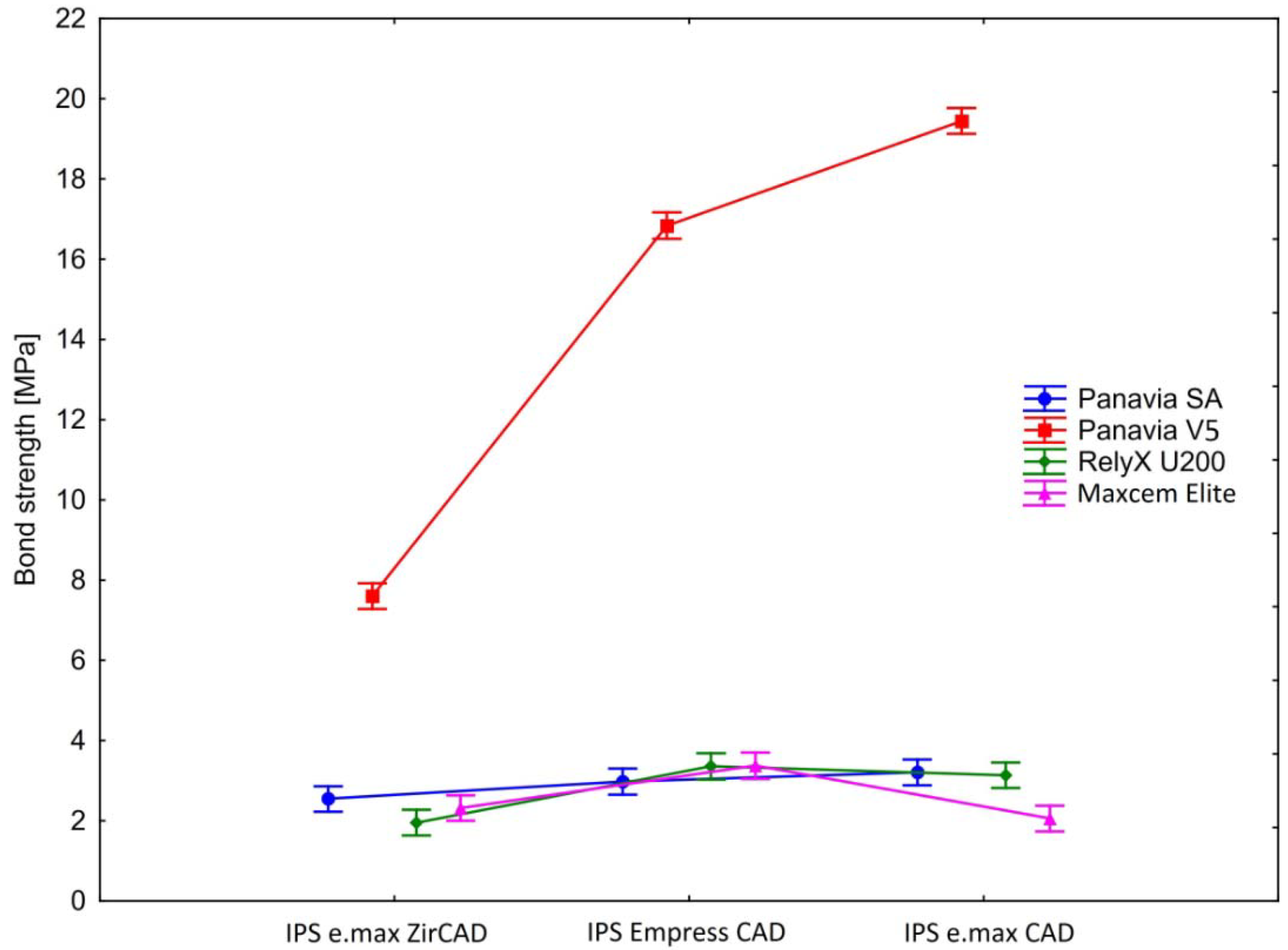
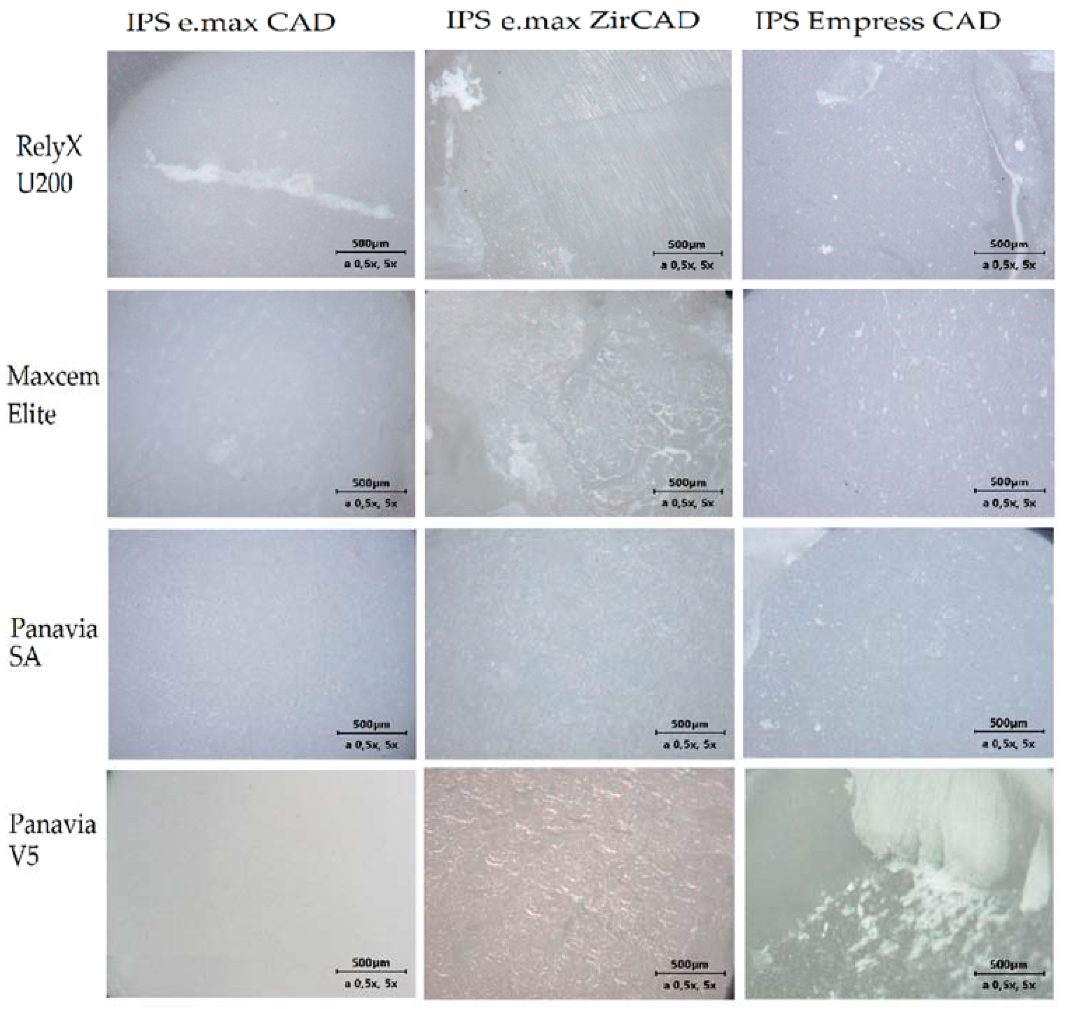
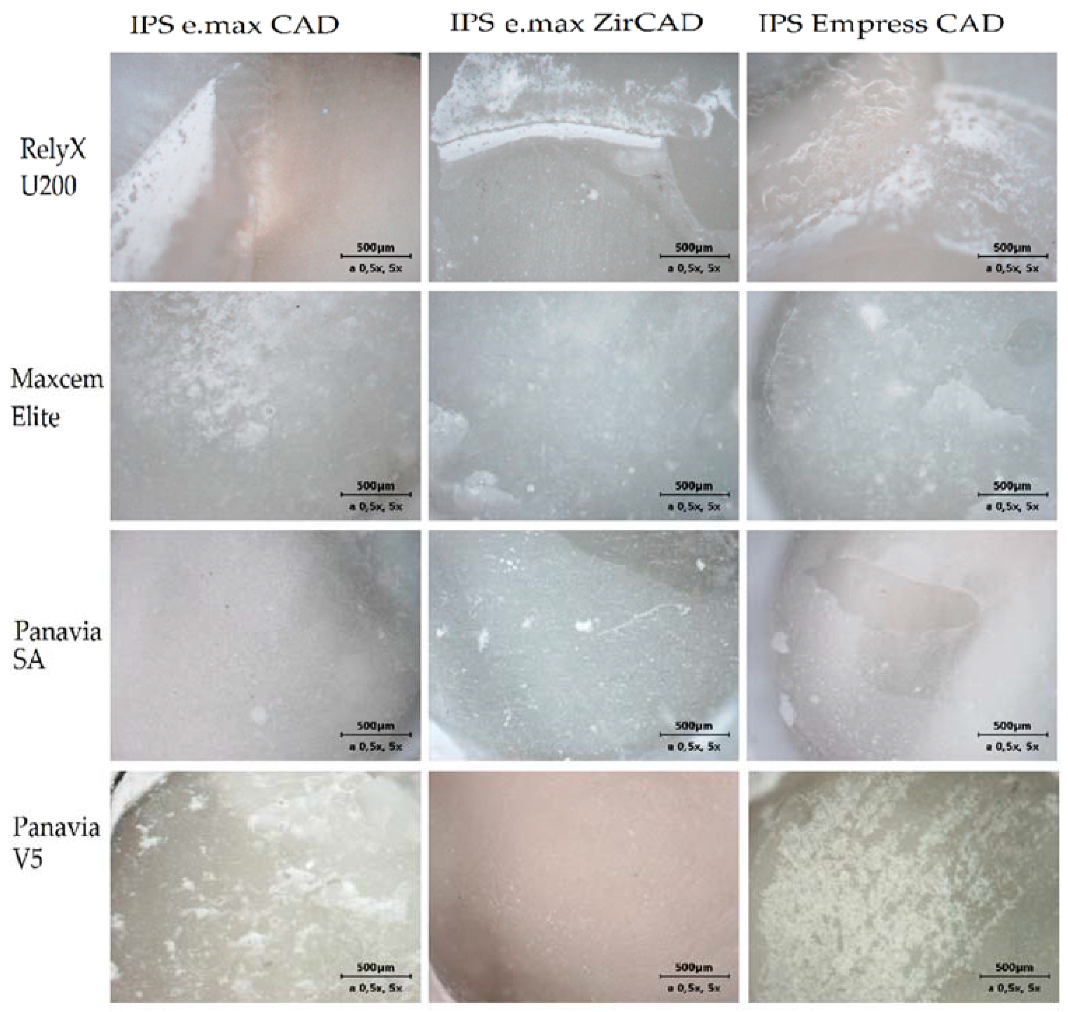
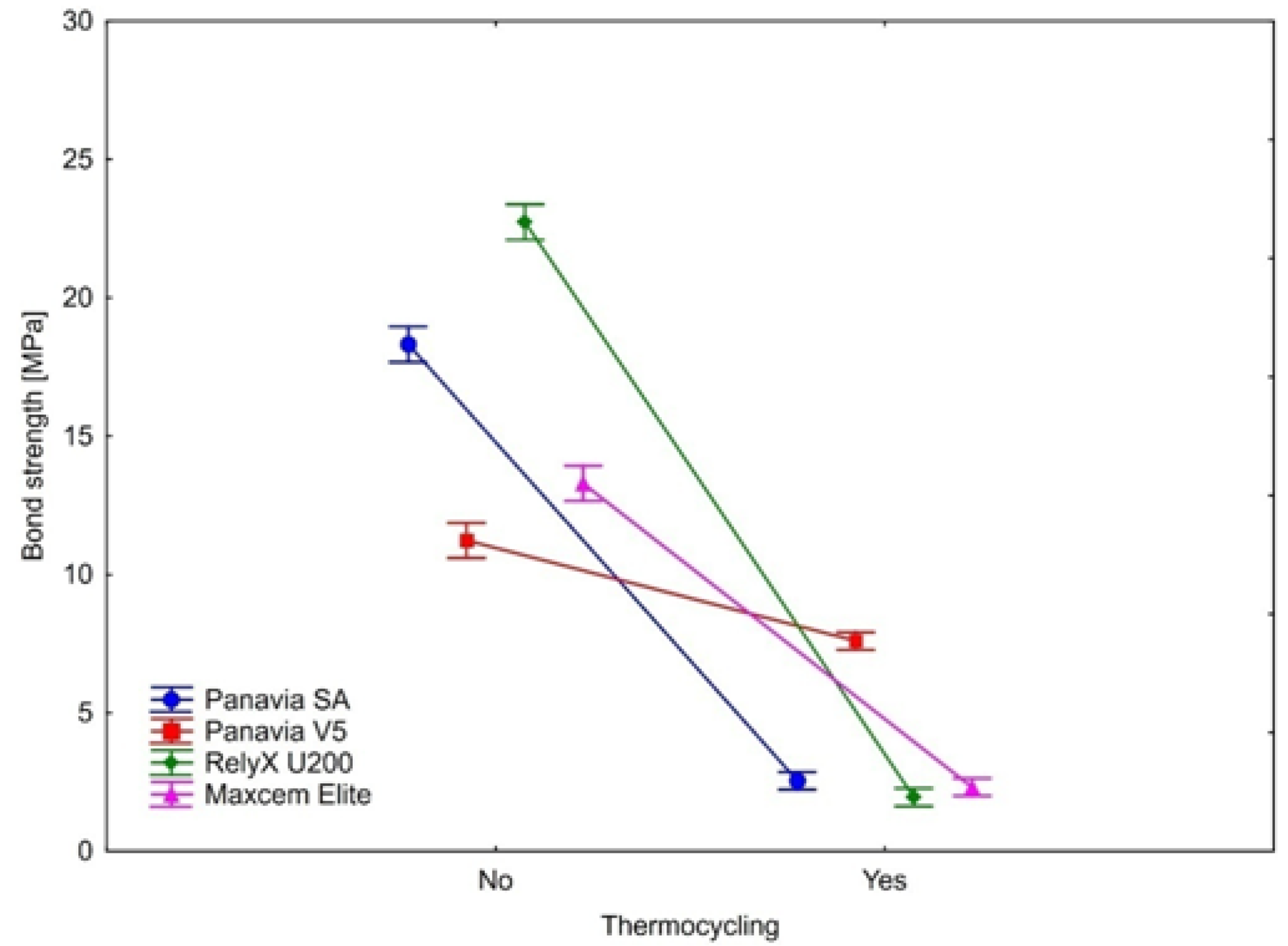

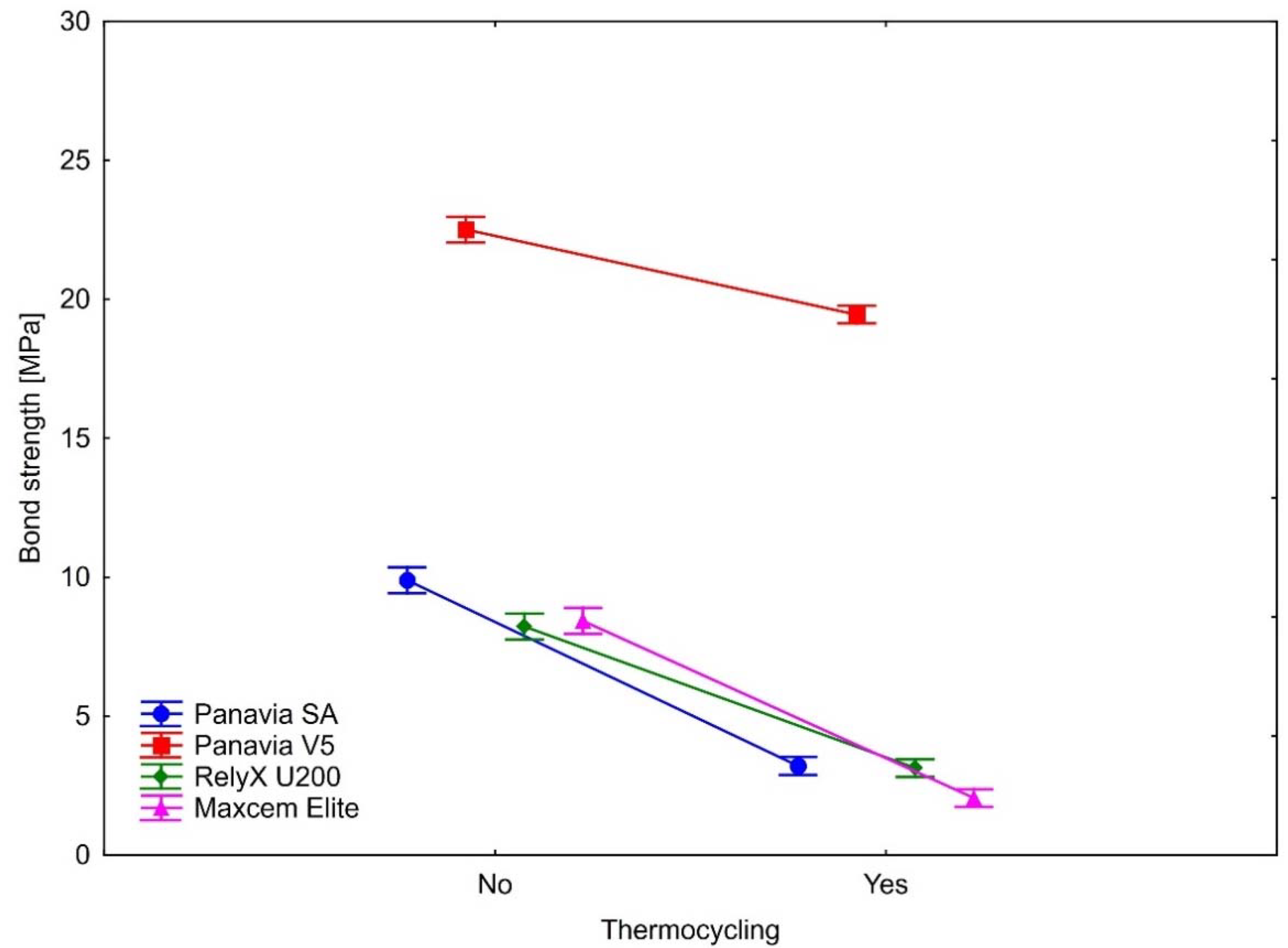

| IPS e.max ZirCAD | IPS Empress CAD | IPS e.max CAD | |||||||
|---|---|---|---|---|---|---|---|---|---|
| Panavia V5 | t (44) | p | Cohen’s d | t (44) | p | Cohen’s d | t (44) | p | Cohen’s d |
| Panavia SA | 22.61 | <0.0001 | 7.542 | 60.07 | <0.0001 | 18.221 | 72.13 | <0.0001 | 28.188 |
| RelyX U200 | 25.26 | <0.0001 | 8.638 | 58.41 | <0.0001 | 21.586 | 72.46 | <0.0001 | 28.135 |
| Maxcem | 23.63 | <0.0001 | 9.496 | 58.35 | <0.0001 | 21.783 | 77.25 | <0.0001 | 34.233 |
| Ceramic | Resin Cement | Failure Mode [%] | |||
|---|---|---|---|---|---|
| Adhesive Failure at Dentin/Cement Interface | Adhesive Failure at Ceramic/Cement Interface | Cohesive Failure in Cement | Mixed Failure | ||
| IPS Empress CAD | RelyX U200 | 58.4 | - | - | 41.6 |
| Maxcem Elite | 66.7 | - | 33.3 | - | |
| Panavia SA | 75 | - | 25 | - | |
| Panavia V5 | - | - | 33.3 | 66.7 | |
| IPS e.max CAD | RelyX U200 | 75 | - | 8.3 | 16.7 |
| Maxcem Elite | 83.3 | - | - | 16.7 | |
| Panavia SA | 75 | - | 25 | - | |
| Panavia V5 | 58.4 | - | - | 41.6 | |
| IPS e.max ZirCAD | RelyX U200 | 50 | - | 25 | 25 |
| Maxcem Elite | 66.7 | 16.6 | - | 16.6 | |
| Panavia SA | 50 | 25 | - | 25 | |
| Panavia V5 | 58.4 | 41.6 | - | - | |
| Without Thermocycling | With Thermocycling | Bond Strength Decline | t-Test (df = 11) | Effect Size | |||||
|---|---|---|---|---|---|---|---|---|---|
| Cement | M (MPa) | SD | M (MPa) | SD | M (MPa) | SD | t-Value | p-Value | Cohen’s dz |
| IPS e.max ZirCAD | |||||||||
| Panavia SA | 18.31 | 1.357 | 2.55 | 0.558 | 15.77 | 1.424 | 38.36 | <0.0001 | 11.07 |
| Panavia V5 | 11.23 | 0.475 | 7.60 | 0.765 | 3.632 | 0.875 | 14.37 | <0.0001 | 4.15 |
| RelyX U200 | 22.73 | 1.148 | 1.95 | 0.520 | 20.78 | 1.196 | 60.18 | <0.0001 | 17.37 |
| Maxcem | 13.29 | 1.185 | 2.32 | 0.182 | 10.97 | 1.212 | 31.35 | <0.0001 | 9.05 |
| IPS Empress CAD | |||||||||
| Panavia SA | 16.94 | 1.533 | 2.98 | 0.667 | 13.96 | 1.924 | 25.13 | <0.0001 | 7.25 |
| Panavia V5 | 20.33 | 0.787 | 16.84 | 0.844 | 3.488 | 1.041 | 11.61 | <0.0001 | 3.35 |
| RelyX U200 | 15.13 | 1.953 | 3.36 | 0.260 | 11.77 | 1.895 | 21.51 | <0.0001 | 6.21 |
| Maxcem | 15.48 | 1.158 | 3.37 | 0.229 | 12.11 | 1.274 | 32.92 | <0.0001 | 9.50 |
| IPS e.max CAD | |||||||||
| Panavia SA | 9.888 | 0.926 | 3.209 | 0.588 | 6.679 | 1.162 | 19.91 | <0.0001 | 5.75 |
| Panavia V5 | 22.50 | 0.690 | 19.45 | 0.564 | 3.059 | 0.952 | 11.13 | <0.0001 | 3.21 |
| RelyX U200 | 8.228 | 0.696 | 3.135 | 0.595 | 5.092 | 0.908 | 19.42 | <0.0001 | 5.61 |
| Maxcem | 8.428 | 0.867 | 2.058 | 0.445 | 6.370 | 0.739 | 29.87 | <0.0001 | 8.62 |
| Name | Type | Manufacturer |
|---|---|---|
| Resin Cements | ||
| RelyX U200 A1 | Self-adhesive, self-etch | 3M ESPE (Maplewood, MN, USA) |
| Maxcem Elite A1 | Self-adhesive, self-etch | Kerr (Brea, CA, USA) |
| Panavia SA Cement Universal A1 | Self-adhesive, self-etch | Kuraray Noritake (Tokyo, Japan) |
| Panavia V5 A1 | Adhesive | Kuraray Noritake (Tokyo, Japan) |
| Ceramics | ||
| IPS Empress CAD HT A1 | Leucite glass | Ivoclar Vivadent (Schaan, Liechtenstein) |
| IPS e.max CAD HT A1 | Lithium disilicate | Ivoclar Vivadent (Schaan, Liechtenstein) |
| IPS e.max ZirCAD | Zirconia | Ivoclar Vivadent (Schaan, Liechtenstein) |
Publisher’s Note: MDPI stays neutral with regard to jurisdictional claims in published maps and institutional affiliations. |
© 2022 by the authors. Licensee MDPI, Basel, Switzerland. This article is an open access article distributed under the terms and conditions of the Creative Commons Attribution (CC BY) license (https://creativecommons.org/licenses/by/4.0/).
Share and Cite
Malysa, A.; Wezgowiec, J.; Grzebieluch, W.; Danel, D.P.; Wieckiewicz, M. Effect of Thermocycling on the Bond Strength of Self-Adhesive Resin Cements Used for Luting CAD/CAM Ceramics to Human Dentin. Int. J. Mol. Sci. 2022, 23, 745. https://doi.org/10.3390/ijms23020745
Malysa A, Wezgowiec J, Grzebieluch W, Danel DP, Wieckiewicz M. Effect of Thermocycling on the Bond Strength of Self-Adhesive Resin Cements Used for Luting CAD/CAM Ceramics to Human Dentin. International Journal of Molecular Sciences. 2022; 23(2):745. https://doi.org/10.3390/ijms23020745
Chicago/Turabian StyleMalysa, Andrzej, Joanna Wezgowiec, Wojciech Grzebieluch, Dariusz P. Danel, and Mieszko Wieckiewicz. 2022. "Effect of Thermocycling on the Bond Strength of Self-Adhesive Resin Cements Used for Luting CAD/CAM Ceramics to Human Dentin" International Journal of Molecular Sciences 23, no. 2: 745. https://doi.org/10.3390/ijms23020745
APA StyleMalysa, A., Wezgowiec, J., Grzebieluch, W., Danel, D. P., & Wieckiewicz, M. (2022). Effect of Thermocycling on the Bond Strength of Self-Adhesive Resin Cements Used for Luting CAD/CAM Ceramics to Human Dentin. International Journal of Molecular Sciences, 23(2), 745. https://doi.org/10.3390/ijms23020745







